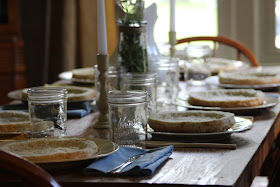A glimpse at the daily-life-and-times of the middle ages is a study of societal extremes. For the most part, people were either wealthy or impoverished. There wasn't a middle class.
After reading about the lifestyle differences of the lavished and the lowly, we decided to live it out...for at least one meal. We invited one of our favorite homeschooling families, who just also happened to be learning about the medieval period, to join us for a historic feast.
We wanted to make our meal as accurate as possible, so we read about feasting in the following books and made a plan:
We set our table with nobility in mind. We included shortened wooden spoons, knives, and cloth napkins. Sadly, I could not find wooden or metal goblets.
Italian style forks did not make their way into Europe until the late 11th century. So we did not include them on our table scape. It was typical for meals to be served on trenchers, flat round bread loaves. Often these were old loaves of bread that were hollowed out to make a shallow bowl. After the meal, the trenchers were usually tossed out to the peasants who would eat them along with any drippings that were left.
For the sake of my dining room table, we placed our bread trenchers over standard dinner plates.
I consulted Medieval Cookery for when planning our menu.
Medieval Menu
Sauce Madame- This recipe is meant to be used with goose, but I used a large chicken instead. In addition, my local grocer did not have quince, savory, or galingale. After some online research, I replaced them with extra pears, thyme, and ginger.
The idea that people drank beer during the middle ages to avoid diseased and polluted water is a common misconception. While people may have preferred wine and ale, they also drank plenty of water from wells and fresh springs.
We served water and homemade non-alcoholic honey mead at our table.
Honey Mead Recipe
Mix together the following. Chill and serve.
- 2 quarts water
- 1/2 c. honey (or more if you'd prefer)
- juice of one lemon
- pinch of nutmeg
The King's Cake
Tradition says that on January 6 (Twelfth Night or the Feast of Epiphany), to commemorate the visit of the Magi, the people of medieval Europe celebrated with a King's Cake. While it wasn't winter or anywhere near Twelfth Night when we hosted our feast, we decided to include this historic feast day lore.
My friend made some delicious Lemon Cakes and hid a bean in one of them. At the close of the meal, the lucky dinner guest who found the bean was crowned KING for the remainder of the day.
For a few short hours, we ate like medieval kings. We lifted our glasses and leaned into the past. We learned through living.
Huzzah!








How fun. What a great event. I'll need to try something out. I also lovw you documented the memories!
ReplyDeleteIt was a fun night!
Delete